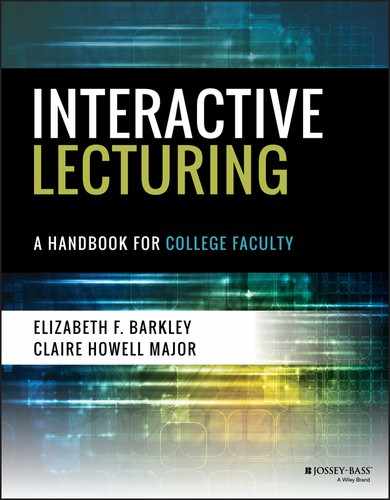ENGAGING LECTURE TIP 29
Dress for Success
One thing that many of us find appealing about the professoriate is the lack of a formal dress code. Indeed, when we are being socialized into the profession as graduate students, the typical attire can be jeans and sweatshirts. It would be nice to think that what we wear as professors doesn't matter, that students want to learn from us despite our appearances. However, there is evidence to suggest that what we wear does matter to students. They have indicated that they pay attention to our attire in plenty of student evaluations (and likewise in students' discussions of their professors on Twitter) in which they focus on what the teacher has worn rather than the teacher's teaching effectiveness. We suspect that our attire matters to many of our colleagues as well. Although most of us clearly have the general idea that we need to dress professionally, there are a few special considerations for those of us dressing specifically for our teaching roles.
A few suggestions for dressing for success:
- Dress in something that makes you feel like you look good. It helps to feel like a million dollars when you are giving a lecture. Ensuring that you do will increase your confidence level, and students will be able to sense that.
- Dress in something that allows you to move. Don't wear clothes that restrict your movement. Most of us don't stay fixed in the exact same position throughout a lecture, and our clothing needs to go along with us. Don't wear anything painful—like an overly tight waistband or shoes that hurt your feet. Students will be able to sense your discomfort, even if they can't identify the source of it.
- Dress consistently with the persona you are trying to convey. As college instructors, we craft our own teaching personas, whether we do so intentionally or unintentionally. Our clothing contributes to that. We may adopt the traditional dress of the professors (the tweed coat and button-down), or we may choose to intentionally subvert it and dress more casually.
- Dress to signal your professional affiliation. We may decide to go formal with a suit and a tie or heels if those are the norms of our disciplinary fields (e.g., if we teach in law or business). We may go with upscale casual, for instance, if we teach in teacher education. Or we wear clothing that is field or discipline specific, for example, lab coat if we teach a science lab, dance attire if we teach dance, exercise clothes if we teach physical education, or a smock if we teach art. What we wear signals our professional affiliation.
- Dress like a grown-up. Whatever you decide to wear to convey your persona, it is probably a mistake to try to look hip, trendy, or like a student because doing so can make professors look foolish.
Example
Key References and Resources
- Jensen, E. (2008). A call for professional attire. Inside Higher Ed. Retrieved from www.insidehighered.com/views/2008/02/08/call-professional-attire
- Lang, J. M. (2005). Looking like a professor. Chronicle of Higher Education, 51(47). Retrieved from http://old.biz.colostate.edu/mti/tips/pages/LookingLikeaProfessor.aspx
- Morgan, N. (2013). How to avoid disaster: Six rules for what to wear when giving a speech. Forbes. Retrieved from www.forbes.com/sites/nickmorgan/2013/12/05/how-to-avoid-disaster-six-rules-for-what-to-wear-when-giving-a-speech/#2c5dd6022dce
